Showing Spotlights 1961 - 1968 of 2779 in category All (newest first):
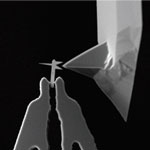 The folks at the European NanoHand project, whose nanogripper design we have covered in a previous Nanowerk Spotlight, seem to have loved playing with their plastic toy kits as kids. At least that's the impression you get when watching their latest video explaining their proof-of-principle study of scanning probe tips defined by planar nanolithography and integrated with AFM probes using nanomanipulation. They have prefabricated nanoscale needles, to be picked up by nanogrippers inside a scanning electron microscope. They then use these nanobits as ultralong tips in atomic force microscopes. The researchers call the needles 'nanobits' because they are a reminder of drill bits - you can have a library of different nanobits and then pick the one you want, and mount it where you want it.
The folks at the European NanoHand project, whose nanogripper design we have covered in a previous Nanowerk Spotlight, seem to have loved playing with their plastic toy kits as kids. At least that's the impression you get when watching their latest video explaining their proof-of-principle study of scanning probe tips defined by planar nanolithography and integrated with AFM probes using nanomanipulation. They have prefabricated nanoscale needles, to be picked up by nanogrippers inside a scanning electron microscope. They then use these nanobits as ultralong tips in atomic force microscopes. The researchers call the needles 'nanobits' because they are a reminder of drill bits - you can have a library of different nanobits and then pick the one you want, and mount it where you want it.
Sep 9th, 2009
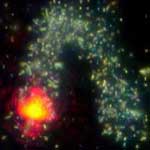 A few years ago it was discovered that the process of thermal inkjet printing can be applied to fabricate hard tissue scaffolds and, just recently, soft tissue with liquid biomaterials. Research is also underway to use inkjet printing for the fabrication of organic semiconductors, opening a route to the fabrication of high-performance and ultra low-cost electronics such as transparent electronics and thin film solar cells. As a matter of fact, the installation of the world's first silicon-ink based solar cell pilot production was completed this January. In your office, though, you have a choice between inkjet printers and (usually much faster) laser printers. And soon, nanotechnologists might have this choice, too. Researchers in California have demonstrated a novel technique for rapidly 'printing' various nanoparticles such as gold nanoparticles, carbon nanotubes, and semiconducting and metallic nanowires, on a photoconductive surface by light, much like a laser printer prints toner powder on paper.
A few years ago it was discovered that the process of thermal inkjet printing can be applied to fabricate hard tissue scaffolds and, just recently, soft tissue with liquid biomaterials. Research is also underway to use inkjet printing for the fabrication of organic semiconductors, opening a route to the fabrication of high-performance and ultra low-cost electronics such as transparent electronics and thin film solar cells. As a matter of fact, the installation of the world's first silicon-ink based solar cell pilot production was completed this January. In your office, though, you have a choice between inkjet printers and (usually much faster) laser printers. And soon, nanotechnologists might have this choice, too. Researchers in California have demonstrated a novel technique for rapidly 'printing' various nanoparticles such as gold nanoparticles, carbon nanotubes, and semiconducting and metallic nanowires, on a photoconductive surface by light, much like a laser printer prints toner powder on paper.
Sep 8th, 2009
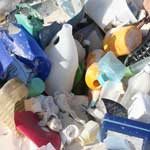 There is no denying the fact that plastic wastes have caused serious environmental problems - and continue to do so. Everyday plastic products, for instance water bottles or plastic bags from supermarkets, are so durable that they will either not rot at all or have long biodegradation periods of 50 years and more. Although so-called 'biodegradable' plastic products typically contain chemicals that help them fragment, the additives do not render the plastic biodegradable. While it is important to develop various techniques for the elimination of plastic wastes - landfills, incineration etc. - these solutions typically present several disadvantages such as re-entering the environment and cause re-pollution, loss of natural resources, or depletion of landfill space. Researchers in China have now developed a technique that uses waste plastics as carbon source for synthesizing silicon carbide nanomaterials. This may actually provide an effective method to help solve the environmental pollution of waste plastics.
There is no denying the fact that plastic wastes have caused serious environmental problems - and continue to do so. Everyday plastic products, for instance water bottles or plastic bags from supermarkets, are so durable that they will either not rot at all or have long biodegradation periods of 50 years and more. Although so-called 'biodegradable' plastic products typically contain chemicals that help them fragment, the additives do not render the plastic biodegradable. While it is important to develop various techniques for the elimination of plastic wastes - landfills, incineration etc. - these solutions typically present several disadvantages such as re-entering the environment and cause re-pollution, loss of natural resources, or depletion of landfill space. Researchers in China have now developed a technique that uses waste plastics as carbon source for synthesizing silicon carbide nanomaterials. This may actually provide an effective method to help solve the environmental pollution of waste plastics.
Sep 4th, 2009
 Humans have always tried to improve themselves through 'natural methods' such as physical exercise, diet, meditation, education and training. However, as a new report on human enhancement points out, with ongoing work to unravel the mysteries of our minds and bodies, coupled with the art and science of emerging technologies, we are near the start of the Human Enhancement Revolution. Technology will be a big game changer. While previously technological progress has improved the tools we work with, from the printing press to the steam engine to computers, in the future, technology will change ourselves, our bodies and, possibly, even our minds. A new addresses questions and issues surrounding human enhancement, an area that will become more prominent as advances in nanotechnology, nanomedicine, bionics, synthetic biology and related fields move from the lab to real-world applications.
Humans have always tried to improve themselves through 'natural methods' such as physical exercise, diet, meditation, education and training. However, as a new report on human enhancement points out, with ongoing work to unravel the mysteries of our minds and bodies, coupled with the art and science of emerging technologies, we are near the start of the Human Enhancement Revolution. Technology will be a big game changer. While previously technological progress has improved the tools we work with, from the printing press to the steam engine to computers, in the future, technology will change ourselves, our bodies and, possibly, even our minds. A new addresses questions and issues surrounding human enhancement, an area that will become more prominent as advances in nanotechnology, nanomedicine, bionics, synthetic biology and related fields move from the lab to real-world applications.
Sep 2nd, 2009
 Much of EPA's focus over the past several years has been aimed at filling information gaps and gathering more data regarding the potential risks associated with nanomaterials, mostly through voluntary programs and agency-funded research. Recently, EPA has moved to quicken the pace of its regulatory efforts, through a series of actions taken under the authority of the Toxic Substances Control Act (TSCA). The agency has also fired a clear shot across the bow of the nanotechnology industry, warning producers and importers of nanoscale materials that the agency intends to pursue enforcement actions against companies that fail to heed EPA's new focus on regulating nanomaterials under TSCA. In light of these developments, companies with an interest in nanotechnology may want to reexamine the agency's recent regulatory initiatives, in order to gain a better understanding of how those actions might affect them.
Much of EPA's focus over the past several years has been aimed at filling information gaps and gathering more data regarding the potential risks associated with nanomaterials, mostly through voluntary programs and agency-funded research. Recently, EPA has moved to quicken the pace of its regulatory efforts, through a series of actions taken under the authority of the Toxic Substances Control Act (TSCA). The agency has also fired a clear shot across the bow of the nanotechnology industry, warning producers and importers of nanoscale materials that the agency intends to pursue enforcement actions against companies that fail to heed EPA's new focus on regulating nanomaterials under TSCA. In light of these developments, companies with an interest in nanotechnology may want to reexamine the agency's recent regulatory initiatives, in order to gain a better understanding of how those actions might affect them.
Sep 1st, 2009
 According to the World Health Organization, lung cancer is the leading cancer-related cause of death, accounting for 18 percent of cancer deaths and killing about 1.3 million people worldwide every year. Conventional diagnostic methods for lung cancer occasionally miss tumors and they are costly and unsuitable for widespread screening. Breath testing is a fast, non-invasive diagnostic method that links specific volatile organic compounds (VOCs) in exhaled breath to medical conditions. However, these techniques - gas chromatography/mass spectrometry, ion flow tube mass spectrometry, laser absorption spectrometry, infrared spectroscopy, polymer-coated surface acoustic wave sensors and coated quartz crystal microbalance sensors - are expensive, slow, and require complex instruments. A multidisciplinary research team at Technion - Israel Institute of Technology have now demonstrated a highly sensitive, stable, relatively inexpensive, and fast-response nine-sensor array that consists of gold nanoparticles functionalized with different organic groups that respond to various VOCs that are relevant to lung cancer.
According to the World Health Organization, lung cancer is the leading cancer-related cause of death, accounting for 18 percent of cancer deaths and killing about 1.3 million people worldwide every year. Conventional diagnostic methods for lung cancer occasionally miss tumors and they are costly and unsuitable for widespread screening. Breath testing is a fast, non-invasive diagnostic method that links specific volatile organic compounds (VOCs) in exhaled breath to medical conditions. However, these techniques - gas chromatography/mass spectrometry, ion flow tube mass spectrometry, laser absorption spectrometry, infrared spectroscopy, polymer-coated surface acoustic wave sensors and coated quartz crystal microbalance sensors - are expensive, slow, and require complex instruments. A multidisciplinary research team at Technion - Israel Institute of Technology have now demonstrated a highly sensitive, stable, relatively inexpensive, and fast-response nine-sensor array that consists of gold nanoparticles functionalized with different organic groups that respond to various VOCs that are relevant to lung cancer.
Aug 31st, 2009
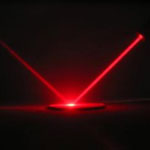 Previously we reported on self-healing nanotechnology anticorrosion coatings, a novel method of multilayer anticorrosion protection including the surface pre-treatment by sonication and deposition of polyelectrolytes and inhibitors. The main novelty of the proposed system was the multi-level protection approach, where the protective systems - the 'smart' multilayers - will not only be a barrier to external impacts, but also respond to changes in their internal structure, and combine in the same system different damage prevention and reparation mechanisms. The team now reports the development of laser-activated nanocontainers filled with corrosion inhibitors. With this new nanomaterial, the healing ability of anticorrosion agents is remotely activated by light.
Previously we reported on self-healing nanotechnology anticorrosion coatings, a novel method of multilayer anticorrosion protection including the surface pre-treatment by sonication and deposition of polyelectrolytes and inhibitors. The main novelty of the proposed system was the multi-level protection approach, where the protective systems - the 'smart' multilayers - will not only be a barrier to external impacts, but also respond to changes in their internal structure, and combine in the same system different damage prevention and reparation mechanisms. The team now reports the development of laser-activated nanocontainers filled with corrosion inhibitors. With this new nanomaterial, the healing ability of anticorrosion agents is remotely activated by light.
Aug 27th, 2009
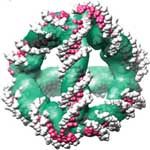 A Japanese-UK research team has now demonstrated that cryoEM image analysis may be exploited to obtain structural information of sufficient resolution to reveal the absolute three-dimensional (3D) configuration of a designed DNA nanostructure. With their technique they have obtained structural information at sufficient resolution to visualize the DNA helix and reveal the absolute stereochemistry of a self-assembled DNA tetrahedron. Each edge is a 7 nm, 20 base pair duplex, and the edges are connected covalently through single unpaired adenosine nucleotides, making it a rigid, triangulated structure that could serve as a building block for larger 3D structures or as a molecular cage. This DNA tetrahedron is the smallest 3D nanostructure made by DNA self-assembly.
A Japanese-UK research team has now demonstrated that cryoEM image analysis may be exploited to obtain structural information of sufficient resolution to reveal the absolute three-dimensional (3D) configuration of a designed DNA nanostructure. With their technique they have obtained structural information at sufficient resolution to visualize the DNA helix and reveal the absolute stereochemistry of a self-assembled DNA tetrahedron. Each edge is a 7 nm, 20 base pair duplex, and the edges are connected covalently through single unpaired adenosine nucleotides, making it a rigid, triangulated structure that could serve as a building block for larger 3D structures or as a molecular cage. This DNA tetrahedron is the smallest 3D nanostructure made by DNA self-assembly.
Aug 25th, 2009
 The folks at the European NanoHand project, whose nanogripper design we have covered in a previous Nanowerk Spotlight, seem to have loved playing with their plastic toy kits as kids. At least that's the impression you get when watching their latest video explaining their proof-of-principle study of scanning probe tips defined by planar nanolithography and integrated with AFM probes using nanomanipulation. They have prefabricated nanoscale needles, to be picked up by nanogrippers inside a scanning electron microscope. They then use these nanobits as ultralong tips in atomic force microscopes. The researchers call the needles 'nanobits' because they are a reminder of drill bits - you can have a library of different nanobits and then pick the one you want, and mount it where you want it.
The folks at the European NanoHand project, whose nanogripper design we have covered in a previous Nanowerk Spotlight, seem to have loved playing with their plastic toy kits as kids. At least that's the impression you get when watching their latest video explaining their proof-of-principle study of scanning probe tips defined by planar nanolithography and integrated with AFM probes using nanomanipulation. They have prefabricated nanoscale needles, to be picked up by nanogrippers inside a scanning electron microscope. They then use these nanobits as ultralong tips in atomic force microscopes. The researchers call the needles 'nanobits' because they are a reminder of drill bits - you can have a library of different nanobits and then pick the one you want, and mount it where you want it.
 Subscribe to our Nanotechnology Spotlight feed
Subscribe to our Nanotechnology Spotlight feed





